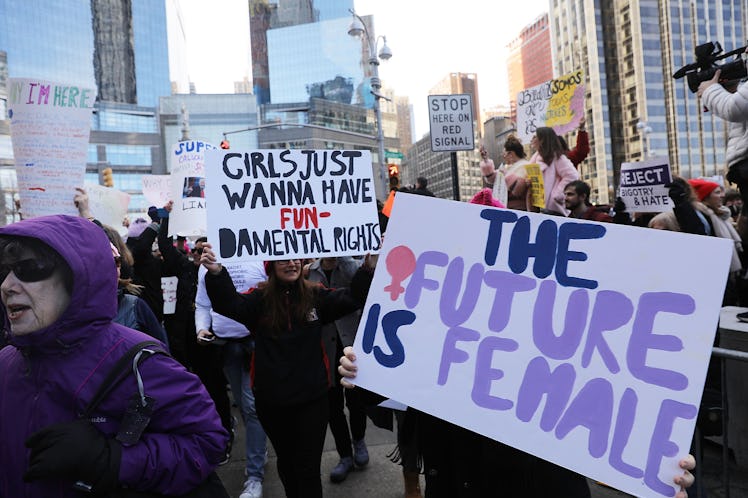
Men & Women Have An Equal Shot At Winning Office, But This Is The Catch
Every time a major election season rolls around, the same questions come up: What do voters want? Can political opponents find common ground? And, are white men more electable than women and people of color? While some of those questions may never be solved — at least not in full — that last one seems to have found its answer, according to a new report from the Reflective Democracy Campaign, a research group which focuses on "disrupt[ing] the demographics of power in the United States."
The June 24 report, titled The Electability Myth, found that while white men hold the majority of the seats of power in the United States, if women and people of color can get on the ballot in a general election, they are elected at the same rates as their white and male opponents.
The report found that in the 2018 midterm elections, 4% of candidates and 5% of those elected were women of color; 28% of candidates and 29% of those elected were white women, and 6% of candidates and 7% of those elected were men of color. In fact, white men were actually the only group to lose more often than they ran — coming in at 61% of candidates but only 60% of winners. “That belief in white men’s electability advantage is simply not based in fact,” the campaign's Director Brenda Choresi Carter said on a press call about the report.
There's a fair amount of pearl-clutching that tends to go on during general elections about which candidates are "electable." While that word can mean just who appeals most to voters, it can also potentially reinforce stereotypes and create a feedback loop that favors the people traditionally in power — namely, white men. As Nate Silver of FiveThirtyEight points out, "electability" can become a self-fulfilling prophecy, in which voters pick not who they themselves would choose, but rather the candidate that they think everyone else prefers.
Funnily enough, that tends to favor white men. As of 2019, the U.S. Congress is still 78% white, and 76% male — although it is the most diverse Congress in United States history, per the Pew Research Center. “[White men] seem electable because they’ve been elected,” said Carter.
Per the Reflective Democracy report, voters' willingness to elect women was apparent in the 2018 midterm elections. Across the board at the local, state, and federal levels, the number of women in elected office has increased by 10% from 2015 to 2019. The number of women in Congress jumped even more sharply, with the number of congressional seats held by women increasing by 23% in the same timeframe.
The report also gave credit to women of color for driving the change. While it notes that women of color currently hold only 4% of elected offices nationally, between 2015 and 2019, the number of women of color in elected office jumped by 30%. The number of women of color in Congress jumped by 41% in the same time period.
So if voters are willing to elect women and people of color, what gives? The short answer, per the report, is that women and people of color face additional barriers to even get on the ballot in the first place. While the report did not focus on gatekeeping or access to resources that may impede diverse candidates from making it to the ballot, it did call out gatekeeping as a barrier. "A number of entrenched barriers continue to protect the starkly unbalanced demographics of political power in America, such as political parties and other gatekeepers, the power of incumbency, and the economic realities of running for and holding office," the report noted.
So, that's one less question leading up to the 2020 election. What to do with that information? Well, you always have options.